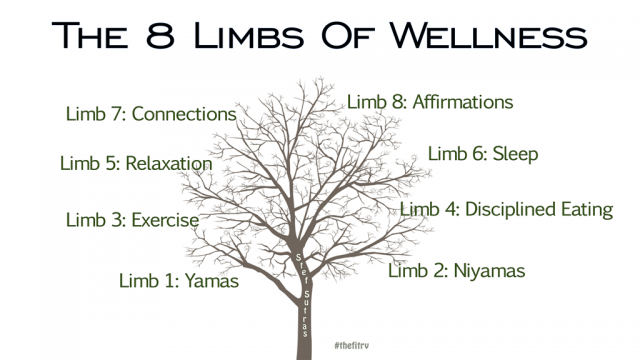This post may contain affiliate links.
I’m so happy… you came back for Part 2! Whether that’s because you’re truly interested in reading about wellness, or just stuck in a long line somewhere, I’m glad you’re here.
Let’s dive right in. Last article, I identified the 8 modified “Stef Sutra” limbs to living well.

Today, I’d like to focus on understanding that first one, the Yamas. “Yamas” is a Sanskrit word meaning “restraint.” So, basically, the Yamas list things we should restrain from doing in our quest to live well.
The 5 Yamas of the Yoga Sutras:
- Ahimsa (don’t cause harm)
- Satya (tell the truth)
- Asteya (don’t steal)
- Brahmacharya (control your urges)
- Aparigraha (don’t be greedy)
Now gang, don’t confuse the motivation behind the yamas. Patanjali doesn’t suggest we follow the yamas in order to be good people. Rather, he’s more concerned that following the yamas will make us healthier, both in mind and body. According to Patanjali, when we stick to the yamas, our lives become more peaceful and no longer dictated by our wants and if only’s. So, a healthier mindframe, which carries over to a healthier body.
Of the 5 yamas, your best bet is to focus on the first one, Ahimsa, and that’s exactly what we’ll be doing in this article. In a way, Ahimsa subsumes any other yamas and all the other 8 limbs. So if you’re overwhelmed by all the limbs and yamas to remember this’ll make you very happy to hear: if you perfect this one yama, you’ve pretty much found wellness. Everything else ties right back to it! I’ll try to point out what I’m talking about as we delve in, but I’m getting ahead of myself. Let’s back up.
Ahimsa: What Is It?!?
The prefix “a” in Sanskrit means “not,” while himsa means “harming, injuring, killing, or doing violence.” Now it doesn’t take a rocket scientist (or even a personal trainer) to figure out how to not-be-violent in a literal sense…you know, like don’t go around slapping people. I’d like to hope we’ve all got that ethical code already ingrained. So, start by replacing the term violence with the term harm. Understanding the ways we do harm, and then practicing ways to AVOID doing harm…well gang that there is the entire key to living Ahimsa.

To help you gain a greater understanding of Ahimsa, it helps when you classify it into 4 different parts:
- Don’t harm other people.
This is what we tend to jump to when we think of the word violence…physically hurting other people. Beyond physical injury, we can do emotional harm, too. Teasing, criticizing, bullying, belittling, pick any negative gerund you’d like…they’re all ways we can do harm to others. When we drive aggressively when another driver annoys us, or lose our temper at a customer service employee on the other end of the line, well then we’ve stepped backwards on our Ahimsa training for the day.
But there’s another side to this…when the others cause harm to us. When we are harmed, the practice of Ahimsa tells us that no matter how violent the act, we should always attempt forgiveness. Holding on to grudges, anger, and hostility doesn’t do anything to damage the person who did the harming. It only continues to damage us. Practicing Ahimsa means learning to accept, forgive, let go, and move forward.
- Don’t harm your body.
When we’re trying to achieve total wellness, the body and mind have got to be on the same page. Think of it like the two being partners on the same journey. When the body gets what it needs, it gives back. So if we eat in moderation and only eat the good stuff, the body responds with energy and a healthy composition. When we give our body the exercise it requires, the body gives back strength and vitality. When our mind makes sure our body is getting enough pillow time, again…the body responds favorably. The trouble is, the mind gets all the control here. The body needs things, and can’t get them unless the mind is in a giving mood. And that’s how the whole wellness system crumbles. Having that disconnect in the mind-body relationship, and not nurturing it the way it needs to be nurtured, causes harm to your body.
I told you I’d point this out as we rolled along… the 3 examples I just used; eating, exercise, and sleep, they’re 3 of the 8 limbs identified in Part One. Remember earlier when I said all the other limbs are enveloped within this one Yama? Here’s a great example of that. You can’t practice Ahimsa without touching the other limbs!
- Control your harmful thoughts.
If we’re going to be honest, and we NEED to start being honest if we want to live better… we can be pretty mean. I’m not talking about outwardly. We’re all masters of keeping our mean thoughts hidden. But they’re there…and since they’re up there safely tucked away in our brains, we probably see them as harmless. They aren’t.
And since we’re on the “being honest” kick, tell me if I’m off base here. The person in your life that you’re most likely hardest on, cruelest to, and least compassionate towards is probably yourself.
I’ll give us humans this, we’re all brilliant at WANTING change or something better. But we’re also great at criticizing ourselves for not achieving it. Some of it comes back around to that mind-body dysfunctional relationship…something I see frequently in personal training clients who come to me for weight-loss guidance. The mind is frustrated about the body’s limitations and flaws, even though the body is at the mind’s mercy. If we can’t nurture that mind-body relationship, we’ll continue to be disconnected from ourselves and stuck in a cycle of thoughts that do self-harm.
Again, we’re seeing how Ahimsa is tied to the other limbs, because the 8th limb, ‘Affirmations’, is very much tied to this part of living Ahimsa. Using affirmations, we can learn to reset our negative thoughts and have a more positive outlook about ourselves and life in general.
- Don’t harm the planet.
Ahimsa is all about living well through kindness, and that includes being kind to our planet. So if you want to fully live Ahimsa, you try to leave a smaller footprint, own less things, and live closer to simplicity. Spending time in nature is another big part of that since it reduces stress and increases positive feelings. It contributes to your physical wellbeing, reducing blood pressure, heart rate, muscle tension, and the production of stress hormones.
So there you go, Ahimsa in 1,000 words. But so we’re clear, learning to live without doing harm…well gang, that’s a life-long journey. It takes incredible work, beginning with repairing the relationship-gone-wild between your mind and body. It takes tons of patience too, because we all have that set-point of how we think and act…and our tendency is to default back to it if we let our guard down. With persistence though, I truly believe we all have the capacity to transform ourselves; living calmer, fitter, and more contented lives.

Part 2 Homework:
My intent today was not only an introduction to the concept of Ahimsa, but also to get you contemplating it and how it could improve your own well-being. So, information AND action. This homework assignment will give you a chance to do just that.
Directions: Look back at the 4 different parts of Ahimsa, which are avoiding 1) harm to others, 2) harm to your body, 3) harmful thoughts, and 4) harm to the planet. For each part, write down one thought on how you could start your journey practicing it. Put them somewhere safe and private. Every once in a while check back in with them and see how you’re doing.
And as always, I love to hear your reactions to this series. Leave your thoughts in the comments below! And if you’re ready to read on to Part 3 in this article series, CLICK HERE.
Rooting for you!
Love, Trainer Stef











I’ve been following you guys for years on our journey to getting an RV, which we finally pick up next week. Unfortunately, I never looked at your wellness articles. I’m glad I found them today. You write very well and have a great way of explaining things. I’m hoping that working on Ahimsa will help me finally stick with exercise.
Thanks!
How exciting, a new RV next week!!! So excited for you, I still remember vividly getting our first one and all the excitement that came along with it. Thanks for your kind words on my writing (and on Nat’l Kindness Day, too)! Best of luck with your new coach; and may your adventures ahead be INCREDIBLE! xo
Stef you had me until own less things and live closer to simplicity. I’ll just follow along and incorporate the rest of the plan.
lOLLL! It’s certainly open to interpretation about owning less stuff and clearing out the clutter… less for you can mean something very different than less for someone else. The main point is simplifying. Anyways, I certainly hear you. I’m still having a hard time letting go of all my old running shoes… some even over a decade old!!!
Just found this by chance. Nice, easy, simplistic and to the point, (in a good way!) no wasted words. My hats off to you girl, can’t wait to read more, you have a gift. Thanks for sharing it with all of us.
Wow, Tim! How very “ahimsa” of you to say! Thanks for that dose of kindness, I truly appreciate it. xoxo
Lovely! Getting older has taught me that I need this kind of “refresher” now and again. I look forward to the rest of the series. Thank you!
Glad you found it useful, Kelli! And actually, taking the time to leave a few kinds words here…well, that there was putting Ahimsa in practice. I’m glad to see it! xoxo